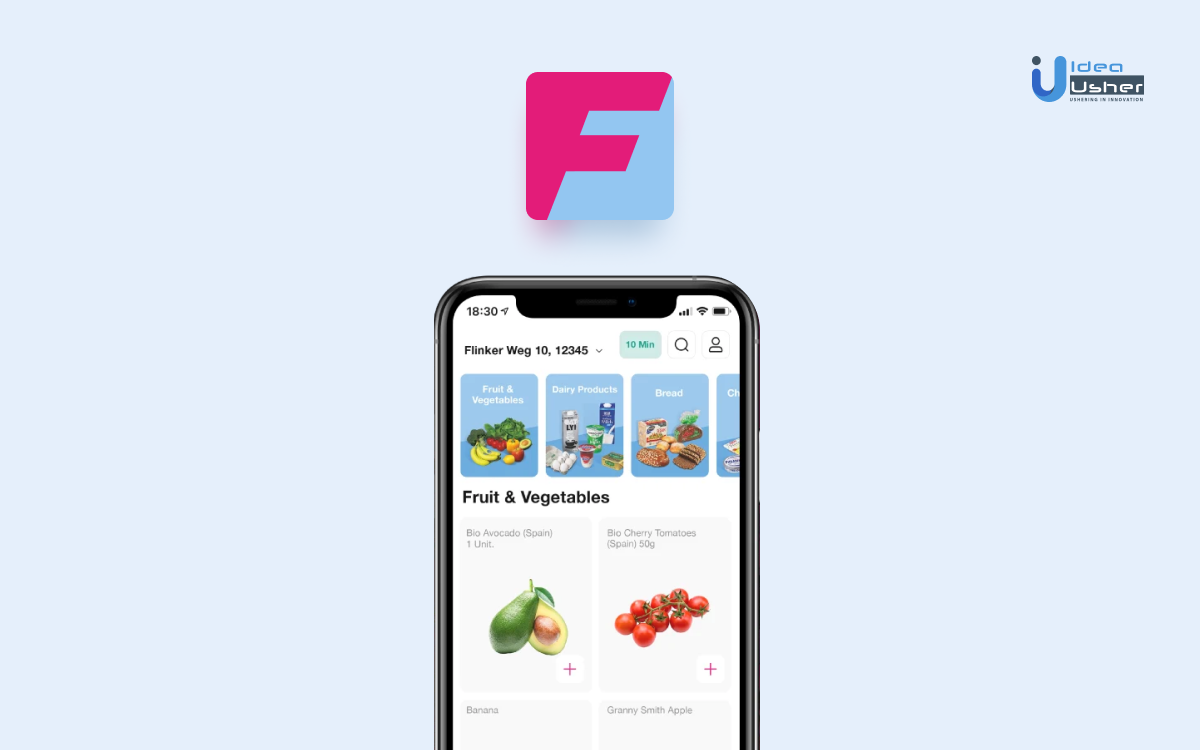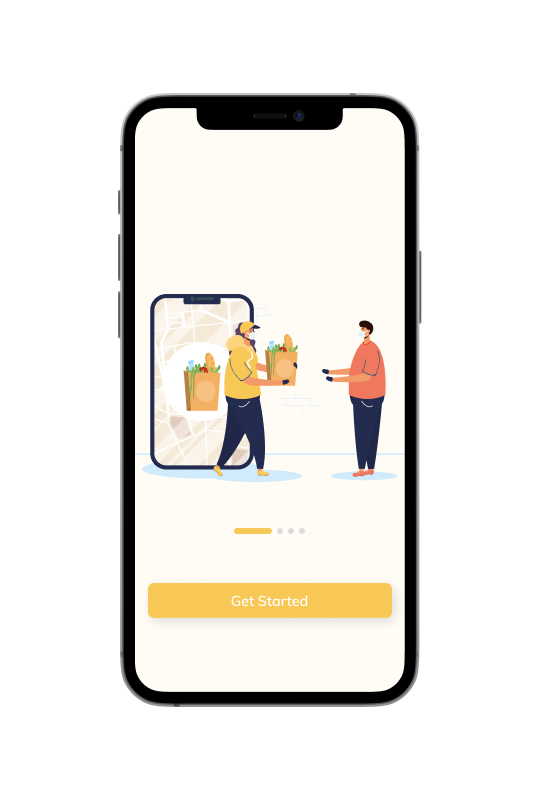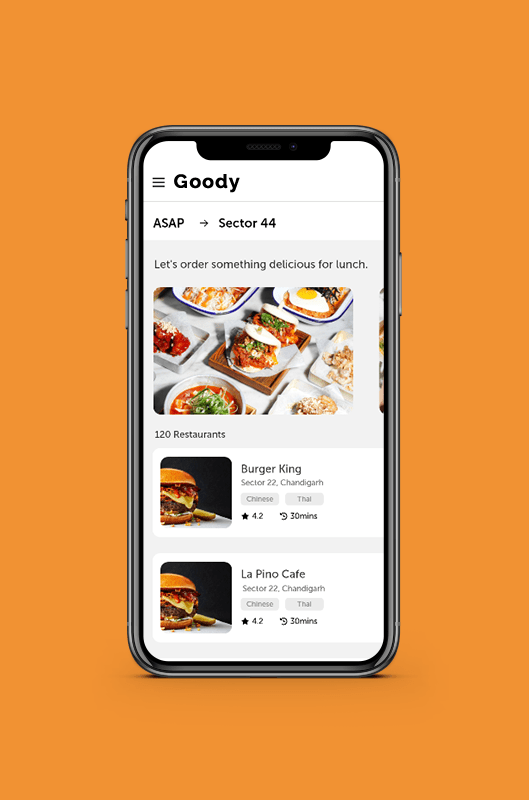How does Flink work? The on-demand grocery delivery business is getting a lot of attention from shoppers and investors alike. After all, who doesn’t love the idea of getting groceries delivered for a perfect dinner date to their door with a few taps on their smartphone?
But how do you make money doing this? How much does an on-demand delivery service cost? And how much would it cost in the future? We’ll look at these questions and more in this blog by exploring a newcomer in the scene: Flink.
What is Flink?
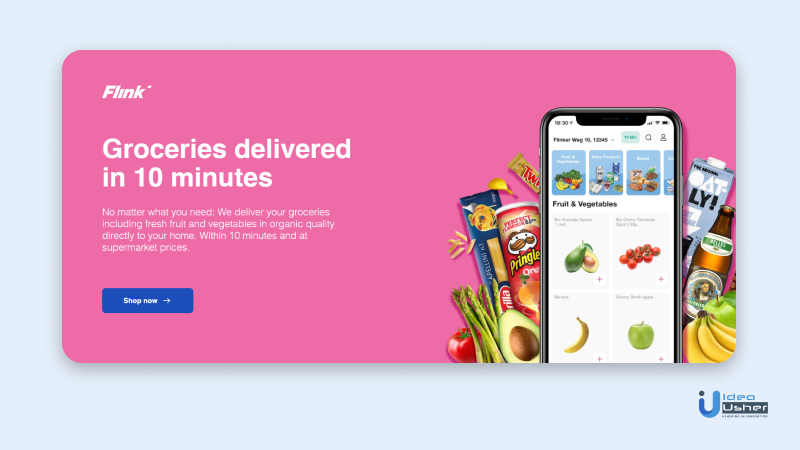
Founded in 2020, Flink’s ability to deliver groceries within 10 minutes is because it operates multiple warehouses in the cities Flink is active in.
A dedicated staff of warehouse pickers collects the items and then hands them over to the drivers. Flink hires the drivers themselves on a full-time basis, and they’re provided with an e-bike to make the deliveries.
Once you enter your address and payment details, you select various items from the hundreds listed in the app. Flink delivers fresh meat and fish, bakery products, eggs and milk, alcoholic beverages, snacks, and dozens more. It is available in four European countries: Austria, Germany, France, and the Netherlands.
Flink: Origin Story
Flink was founded by Oliver Merkel (CEO), Christoph Cordes, and Julian Dames. Merkel had been spearheading the Bain consulting firm’s consumer goods practice in Berlin.
Cordes co-founded food delivery startup Foodora and served as CMO at Foodpanda and VP at Delivery Hero. Before founding Flink, he helped SoftBank build its businesses.
- Christoph Cordes had previously made a six-figure investment in Gorillas, which took Germany by storm when it launched in early 2020 with its novel delivery concept.
- After convincing Cordes and Dames to join them, they raised a first seed round of €10 million that valued the company at €30 million (post-money). They used that money to start then speed up their launch process.
- In late 2020, Flink’s team launched a joint venture with Hamburg-based delivery app Pickery. Saad Saeed and Nikolas Bullwinkel, Pickery’s founders, joined Flink as Directors of Technology and experience.
- Flink was operational in five German cities within a month of its launch, including Munich, Berlin, Cologne, and more. The startup had to set up actual warehouses as well as source products and drivers.
Within two months of its second round of funding, in March 2021, Flink had expanded to operations in the Netherlands and France. It grew nearly as fast as its biggest competitor, Gorillas, and expanded into more cities sooner.
Flink vs. Gorillas
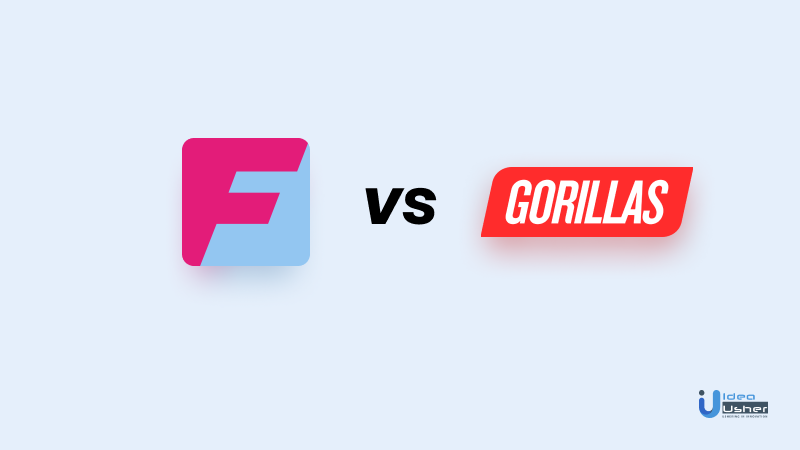
Both Gorillas and Flink promise to deliver groceries within 10 minutes. On-demand grocery delivery has been a thing in major cities over the past years, but most markets haven’t experienced it yet.
Both Flink companies depend on their apps to receive orders, have their crew members fulfill them in retail stores that are converted into warehouses, then deliver the on-demand grocery orders within 10 minutes.
Because everything starts with an app, both apps aim to ensure a smooth experience for their customers.
| Aspects | Flink | Gorillas |
| Devices supported | iPhone, iPad, and Android-enabled devices. | iPhone, iPad, and Android-enabled devices. |
| Target Audience | Individuals and businesses | Businesses |
| Support | Online | Online |
| Onboarding | It doesn’t require immediate registration but asks for permission for location and to track activity. | Requires users to sign up first. Also, it involves notification and location permissions. |
| General Usability | The app is available in the local language. However, the UI seems lacking. | Easy to navigate the app with a highly-functional UI. |
| Checkout Process | Users don’t need to register. They can place an order by providing the essential details, making the checkout process more straightforward. | As users are already registered, the checkout process becomes more accessible. It also includes a simple CTA. |
| Delivery Time | It takes 10 minutes or less. | It may take more than 10 minutes based on the location of the customer. |
Flink is still a newcomer in the market. However, its localized services with quick delivery make it a tough competition for established services like Gorillas.
Working of Flink (on-demand grocery delivery apps)
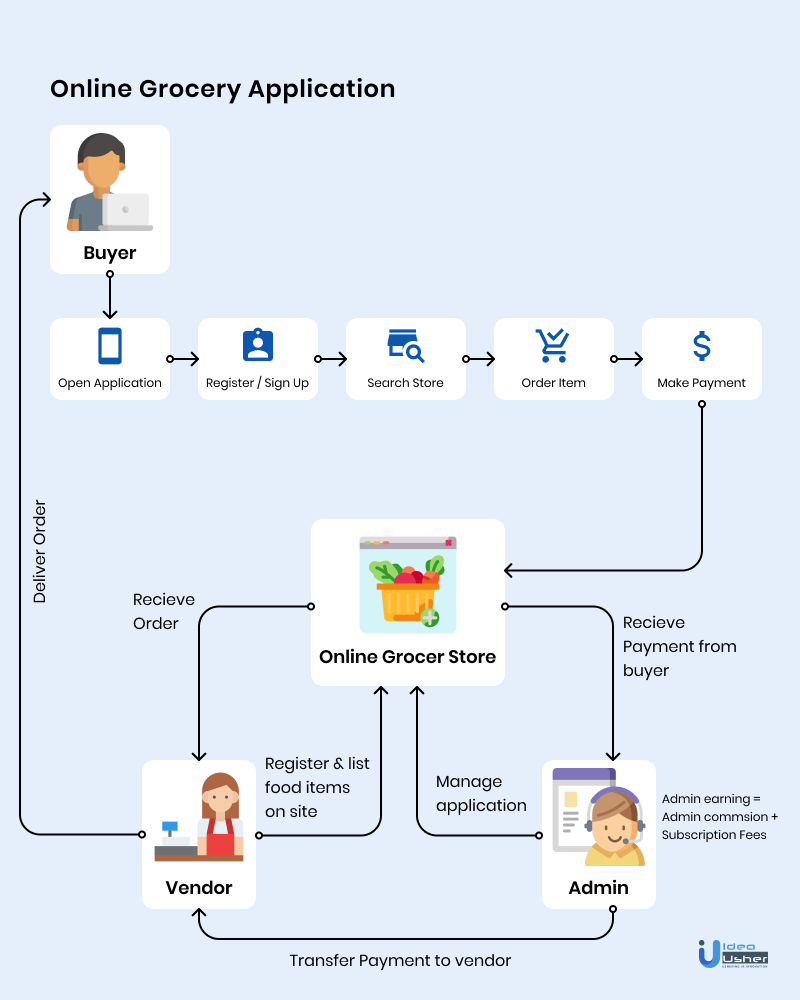
Flink’s on-demand delivery service is bringing groceries to customers’ doors in under 10 minutes. With a simple smartphone interface, customers can:
- order their groceries online via website or through the app,
- Choose a suitable delivery time & slots, and
- find out when the tortilla chips are about to arrive; via real time order tracking
After placing the order, customers can track their food through the Flink dashboard on a map as it’s delivered. Groceries are packed before delivery, so they arrive as fresh as possible. The result is a fast and affordable way for busy people with no time to spare to get their food shopping done without leaving home.
Notable Features of Flink
Understanding dark stores is an intricate part of understanding how does Flink work. These dark stores are local markets turned into warehouses. It is based on the principle that food delivery should be quick and easy for customers, including an array of fresh fruits and vegetables at all times. Here are some of its primary features.
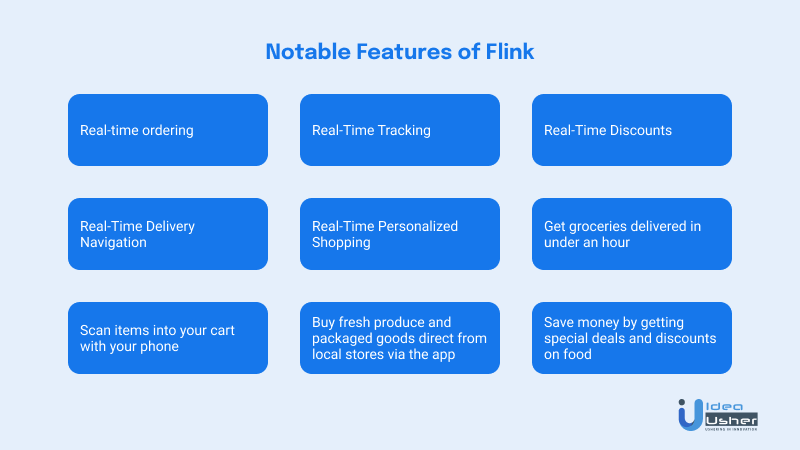
1. Real-time ordering
What sets Flink apart from other grocery delivery platforms is that it gives you the freedom to place your order only when you need it. You can do this by using its Live Order feature or through its Flink App, available for iOS and Android devices.
With Live Order, you can enter the exact items you want to purchase. This ensures that you get your desired items at your preferred time, without any delays or mistakes.
2. Real-Time Tracking
Every time you order groceries, Flink tracks your order in real-time. Once the driver is dispatched, you’ll receive a notification with a photo of your driver and an ETA (Estimated Time of Arrival) of when they’ll arrive.
The app allows you to track the exact location of your driver as they make their way to you, allowing you to see precisely how far away they are so you know when to start getting food out of the fridge.
3. Real-Time Discounts
The app’s real-time discounts are based on several factors, including the type of customer, the time of day, and the weather. Values can be as high as 50 percent off, and they encourage people to make orders when they usually wouldn’t.
4. Real-Time Delivery Navigation
Once an order is placed, you’ll receive a notification with a map of the pickup location as well as a tracking number so you can follow along as your delivery makes its way to your doorstep. You can also update your address at any time!
5. Real-Time Personalized Shopping
Flink is the only full-service grocery shopping app that offers customers a real-time personalized shopping experience. The app lets users shop by scanning their items through the Flink app on their phones, then having them delivered on demand.
6. Get groceries delivered in under an hour.
Flink uses a network of automated warehouses and delivery trucks to make quick deliveries possible. The company’s system tracks each item ordered online and then locates the nearest available driver to deliver it. That allows customers to place orders for fresh food and other perishable items, which can be returned within an hour.
7. Scan items into your cart with your phone
Flink’s app features a barcode scanner for quick purchases and a map view that lets people see what stores are available in their area. The app also offers a “skip the line” feature to bypass checkout lines at participating stores.
8. Buy fresh produce and packaged goods directly from local stores via the app.
Customers no longer need to make their way to supermarkets or order online but can instead order fresh groceries directly from the storage of their choice.
9. Save money by getting special deals and discounts on food.
Grocery customers on the Flink app will be offered special discounts and exclusive offers, such as free delivery or on-demand delivery on specific days of the week.
How does Flink Incorporate Artificial Intelligence in its Model?
The company has been experimenting with machine learning and artificial intelligence and applying them to the grocery industry. For example, Flink has been testing machine learning algorithms to predict whether or not an item will sell out.
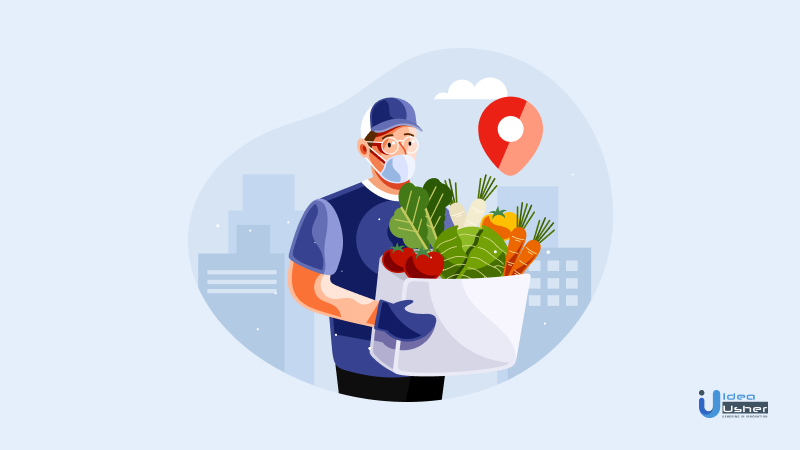
Flink also found that people responded better to personalization, especially their shopping habits and information about their previous orders. Here is how AI can be incorporated into a grocery delivery service.
1. Collect and analyze data
AI technology will predict when shoppers are running out of items and offer suggestions for buying next. It’ll also be able to offer personalized promotions to consumers based on their buying history.
2. Automate operations
Flink’s competitive edge comes from its AI technology that helps automate operations and maximizes efficiency. The app relies on machine learning algorithms to provide an accurate shopping list, which it claims to do by analyzing data from previous orders and preferences. The list is then sent to the customer, who can choose to skip items or make substitutions.
3. Get Adaptable
Flink AI currently analyzes your past purchases and works out what you like and dislike, and predicts future purchases by taking into account your shopping habits (e.g., what you bought last time), prices (e.g., what promotions are on), products (e.g., which brands do you prefer), and product categories (e.g., whether you like healthy food or not).
4. Send Personalised Emails to Customers
Flink can send personalized emails to customers who are more likely to forget an item on their grocery list. The emails include a product image and description along with the message “Did you know you forgot to order….”
Flink Grocery App’s USP
While asking “How does Flink work?”, one of the most essential questions is what are the unique features of the app.
It’s like having your shopping assistant without the expense of hiring one. Its most significant selling point is its founders, each a powerhouse in the field. Listed below are the features that ensure that Flink will be a big-shot app in the coming future.
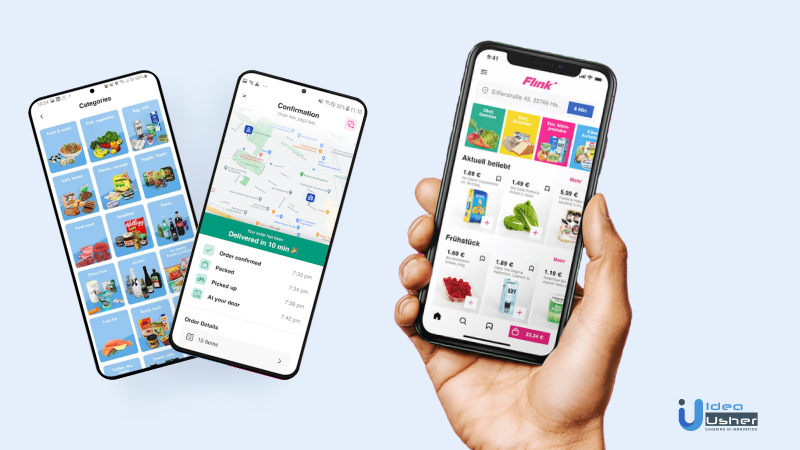
1. Order groceries directly from our vast catalog of the app
Users can search through Flink’s catalog for groceries and other products. They can also add or remove items from their cart and change or select a delivery window and location.
2. Pay through the app.
Flink offers a variety of payment options, including Apple Pay, Samsung Pay, and Android Pay. You can also pay with cash or a bank card without any extra fees.
3. Get all your groceries delivered to your doorsteps in ten minutes.
Flink’s unique business model and proprietary technology enable us to offer the fastest and most convenient delivery service in the market today.
4. Track your orders
Users can track the status of their order at any time on a map within the app, so they know exactly where their package is at all times. They also receive contact information for the store and delivery company.
5. Better deals
Users can save a lot of money by using Flink as they will always find the lowest prices in their area. The merchants offer special discounts and coupons to entice users to try out their service.
6. Convenient for busy lifestyles and students
It offers a grocery delivery service to busy people who don’t want to spend their weekends running errands. It allows customers to order at any time of day or night, seven days a week.
7. Personalized recommendations
Based on your preferences, Flink will recommend personalized offers based on your location, what’s stocked in your fridge, your shopping history with different retailers, etc.
Flink Business Model: Explained
Flink delivers groceries to people who live in Amsterdam, Eindhoven, Groningen, and Hamburg. Customers can order groceries via their website or app instead of physically going to the supermarket. They deliver for free or for € 3,70 (in case of heavy products).
The business model is based on commission fees from stores and a delivery fee from customers. Detailed below are the aspects that can be included in the business model of Flink.
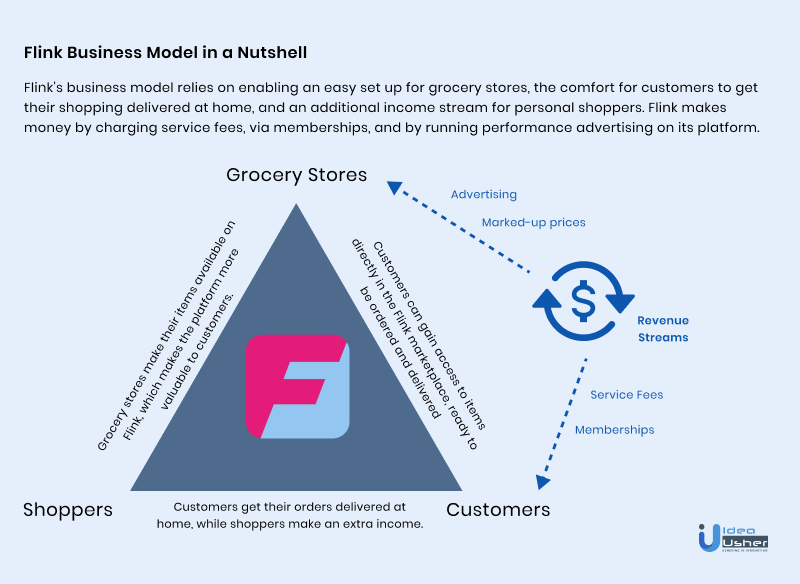
1. Grocery Sales
The majority of Flink’s revenue comes from selling groceries that it has purchased and stored in bulk. Flink, a grocery delivery app, increases its margins by slightly marking up its prices. The company’s products, however, are still significantly less expensive than those at a convenience store.
In addition, through a sourcing deal with REWE, the company likely receives favorable rates for the products it buys in bulk. Furthermore, the startup’s delivery service utilizes small warehouses that are often located in cheaper areas.
2. Delivery Fees
Flink has a relatively low delivery fee which is equal to €1.80 in Germany, for instance. The startup can provide many different services at a low cost because it does not have a minimum order amount.
Fees imposed by the credit card providers (predominantly Mastercard and Visa) as a percentage of the payment volume to cover interchange fees are also applied.
3. Peak Hour Charges
Peak hour charges make a lot of sense for delivery apps. It’s simply an additional fee that some delivery services will charge during high-traffic times of the day or week. If an order is going to take a long time to fill, it makes sense to place it when many drivers are available and the demand for deliveries is relatively low.
4. In-App Advertising
Advertising is another way that food delivery apps make money. Flink, for example, offers ads to grocery stores or restaurants for an additional fee to put them on the top of their search results. When you open the app, you’ll see a few sponsored results at the top.
5. Sales Commission
Food delivery apps are often structured as a commission rate, ranging from 10% to 25%.
Stores are willing to pay commissions because they save on labor costs by not preparing, packing, and delivering orders themselves. The commission rates for these services are typically based on the size of the order. The more food that is purchased at once, the lower the commission rate. This allows restaurants to offer discounts for larger orders that incentivize customers to order more food.
Funding of Flink mobile app
Flink has raised a total of $64 million in funding, including a recent injection from investors. This was preceded by its recent expansion into the Netherlands and France and opened ten dark stores in several German cities.
The funding round is led by Target Global and existing investors Northzone, Cherry Ventures, and Silicon Valley-based debt provider TriplePoint Capital. Cristina Stenbeck, the second-largest shareholder of Kinnevik AB, is also participating in the funding.
With the new financing, Flink hopes to expand further within Germany this year and into additional European markets. In the second quarter of 2021, Flink will open its first stores in the Netherlands and France, which are expected to be located in famous shopping districts in Amsterdam and Paris.
Wrapping Up
We hope now you get all the aspects that answer the question: “How does Flink work?” With its innovative app, Flink aims to reinvent how people shop for groceries by combining centralized buying power with the convenience of on-demand delivery.
Many American cities have embraced “on-demand economies” companies such as Uber and Lyft. Currently, there are more than 300 on-demand grocery delivery services in the US, with an average of 30 percent month-over-month growth.
The market for on-demand grocery delivery is estimated to be $8 billion by 2021, making it one of the fastest-growing industries today. And with Idea Usher, you can get into this market quickly and easily.
Explore your options by contacting our expert developing team now. Reach out to us with a free consultation call.
Build Better Solutions With Idea Usher
Professionals
Projects
FAQs
1. How does Flink app work?
Flink is an on-demand grocery delivery platform that ensures customers to get their groceries delivered within 10 minutes.
2. How does Flink grocery delivery platform make money?
It makes money through the delivery charges received from the customers and commission from grocery stores.
3. How much does it cost to build an on-demand grocery delivery app like Flink?
It depends upon the features and development team you choose. On an average, $5000-$50,000 is the range of cost of development of such an app.
